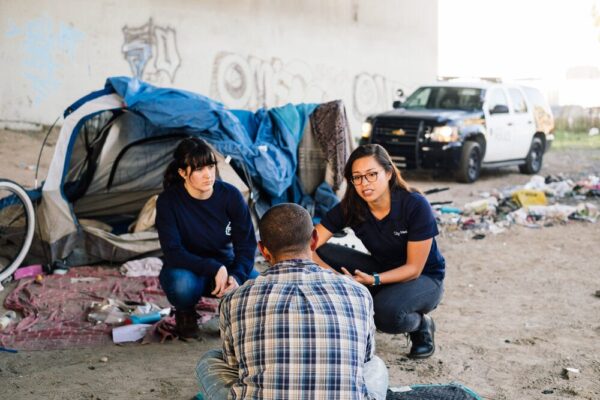By Paul Anderson
The Orange County Commission to End Homelessness on Wednesday heard the results of a groundbreaking survey of hundreds of local transients on what services some of the most chronically unsheltered are seeking.
One of the biggest findings from the survey of 642 transients was that most want to be helped, said Doug Becht, director of Office of Care Coordination for the county.
“This survey is a good example that this is a population that is interested in services,” Becht told City News Service. “This is not a group that wants to be left alone. The key is what services do they want, how to deliver it and when to deliver it.”
Taken in May, the survey focused on the chronically homeless who have not taken advantage of any shelters recently. Of those surveyed, 77% completed the procedure, Becht said.
“They said the average is usually about 70%,” Becht said, referring to surveys done in the past by City Net, the county’s contractor for homeless services.
About 78% were willing to give their names.
“People feel comfortable sharing information if they think it will help them, protect them and it will be respected,” Becht said.
County officials are hoping the survey results will help the commission and the Orange County Board of Supervisors develop new policies of outreach and services for the homeless.
The size of the survey represents about 20% of the county’s homeless population, Becht said, and City Net ensured that the sample reached 20% in each city of the county.
The idea for the survey arose from discussions in the commission about doing another Point In Time count similar to the one done last year, Becht said.
“The commissioners asked about doing a point-in-time count every year or touching this population every year with a survey,” Becht said. “It was too much of a lift to do a point-in-time count in 2023 so we thought let’s take the opportunity to ask questions we couldn’t do in the point-in-time.”
Orange County CEO Frank Kim said that when volunteers were counting the homeless population last year they had to spend most of their time asking questions required by the federal government for grants.
“Just going through the required questions can take 20 minutes and they’re worn out by then so it was difficult to get to the questions we wanted to know,” Kim told CNS. “We had 15 or 20 more we wanted to ask.”
Another point-in-time count will be done next year.
Kim said the county has come a long way in addressing the homeless problem since 2017, when officials would estimate the size of the population through a limited count and extrapolate the results.
“We went out there with a thoughtful survey and we did a real hand count survey and we’ve done that now three times,” Kim said.
The county settled a federal lawsuit in 2019 that has led to the construction of several shelters and getting services to more transients. The survey showed that most of the county’s transients have health insurance through MediCal and were enrolled through the county’s insurance program for the needy, CalOptima.
During the lawsuit, U.S. District Judge David Carter was critical of CalOptima officials for sitting on substantial reserves of money. That led to an effort by Supervisor Andrew Do and others to prod CalOptima to get into the community and sign the needy up for services. Since then, the county has developed programs such as a mobile van that drives around looking for transients to help get them services and ease them into shelters and permanent housing.
“One of the things we had direct control over was outreach workers,” Kim said. “There’s some things we’re doing well and other things we’re trying to figure out the gaps. We clearly have issues with substance abuse and mental health and finding ways to treat them is difficult. You can find somebody at that moment who may be open to services, but at the time of the appointment are they still open to it?”
Kim said one surprising thing was that many transients feel too uncomfortable going into a lobby of offices to get services.
“So we’re trying to figure out how do you reduce as many as barriers as possible to avail themselves of the services,” he said.
Only about 25 of those surveyed had been at a shelter in the days before they were questioned, Becht said. But 80% “of that small group envision moving into permanent housing,” he added.
“A little over 80% said they’ve been homeless for over a year,” Becht said. “A large portion of them said more than three years, so folks have been out there for quite some time.”
Other statistics of note include that 49% reported some sort of substance abuse problem that they’re being treated for or wanted treatment for but could not access. Thirty-eight percent were interested in accessing services right away.
Fifty-eight percent of the respondents said they had a mental health condition that they were being treated for or wanted to get help for.
Ninety-three percent were enrolled in some sort of support service, and 69% meet the federal government’s definition of chronic homelessness.
The most important things transients want from a shelter is safety, respect and personal space, according to the survey. They also want hygiene services including showers.
Fewer than half of the respondents had not been contacted by an outreach worker or case manager in the last three months. Officials recommend extended hours for outreach and case management workers as well as more specific geographic canvassing strategies.
The survey also showed that 85% remained in one area because they’re familiar with it or have friends and family nearby.
Seventy-seven percent of the respondents said their last permanent address was in Orange County and 97% said they spend most of their time in the county. Fifty-seven percent have family in the county and 80% were currently working in the county or did so in the past.
The top reason for leaving a shelter was the rules being too difficult to follow at 17%. Fourteen percent said they had safety concerns, 13% said they had concerns about the staff and 11% had concerns about privacy.
A quarter of the respondents said their top reason for not going to a shelter was lack of an available spot, while 16.7% were concerned about feeling unsafe, 15.9% said they didn’t know how to get to a shelter or access transitional housing programs, 15.5% had privacy concerns and 13.8% cited shelter program rules and policies as being too tough to follow.
The survey also showed that 70.5% cited safety and/or a safe environment as a top feature they want in a shelter, 65.7% want a shelter operator who is respectful, empathetic, helpful or well-regarded, 65.2% noted the amount of personal and private space, and 50.7% said they needed transportation to and from the shelter.
The Board of Supervisors is expected to consider a final report on the survey late this year or in January.







